The chickadee is an iconic feeder bird, whose scolding call reminds you of their name every time you hear it. With a little effort, you can make your garden a haven for Carolina chickadees year-round.
* All photos on this page were taken by me unless otherwise noted. Please provide content and photo credits to thesouthernwildgarden.com.
** The Southern Wild Garden is supported by readers like you! Some links found on this website may be affiliate links, which means I may get a small commission, at no additional cost to you, if you buy a product through one of my links. And as an Amazon Associate, I earn from qualifying purchases through links to Amazon. I only recommend products that I use and love.
Why Carolina chickadees?
It’s difficult not to be charmed by the chickadee. The combination of their sweet little black and white faces with their feisty attitude and acrobatic foraging style bring a smile to my face every time I see one. A small bird with a big personality, your chickadees will be the tiny divas of your yard, scolding you when you forget to refill your feeders and then boldly snatching seeds as you put them out.
Along with their cousins, the tufted titmouse (Baeolophus bicolor), Carolina chickadees will be the first to alert you if something is amiss in your yard. Always on the lookout for predators, chickadees will let you know how big a threat may be to the feathered denizens of your garden by the number of “dees” they add to their eponymous alarm call. Chickadees can actually vary the notes in their “chick-a-dee” call in such a wide variety of ways to signal different things that they are considered to have one of the most complex communication systems in nature.
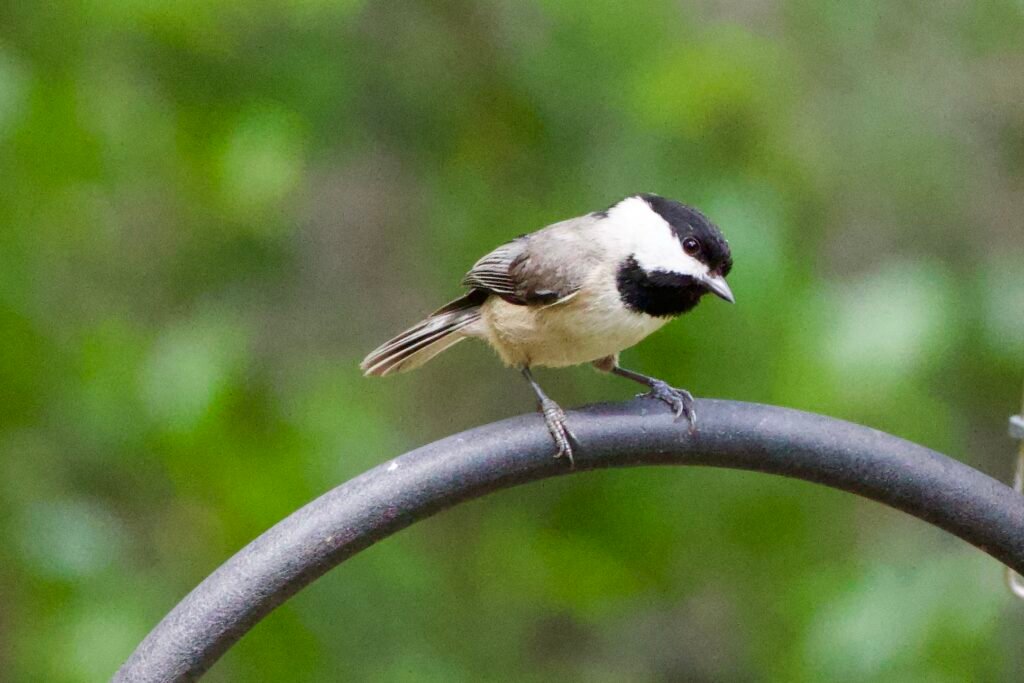
What are Carolina chickadees?
The Carolina chickadee (Poecile carolinensis) is a member of the Paridae family which includes 5 chickadee and 5 titmouse species in North America. Originally called the Carolina titmouse by John James Audubon when he examined the bird in South Carolina in 1833, the naming of the Carolina chickadee apparently reflected Audubon’s “gratitude towards the citizens of that state [for] their hospitality and polite attention.”
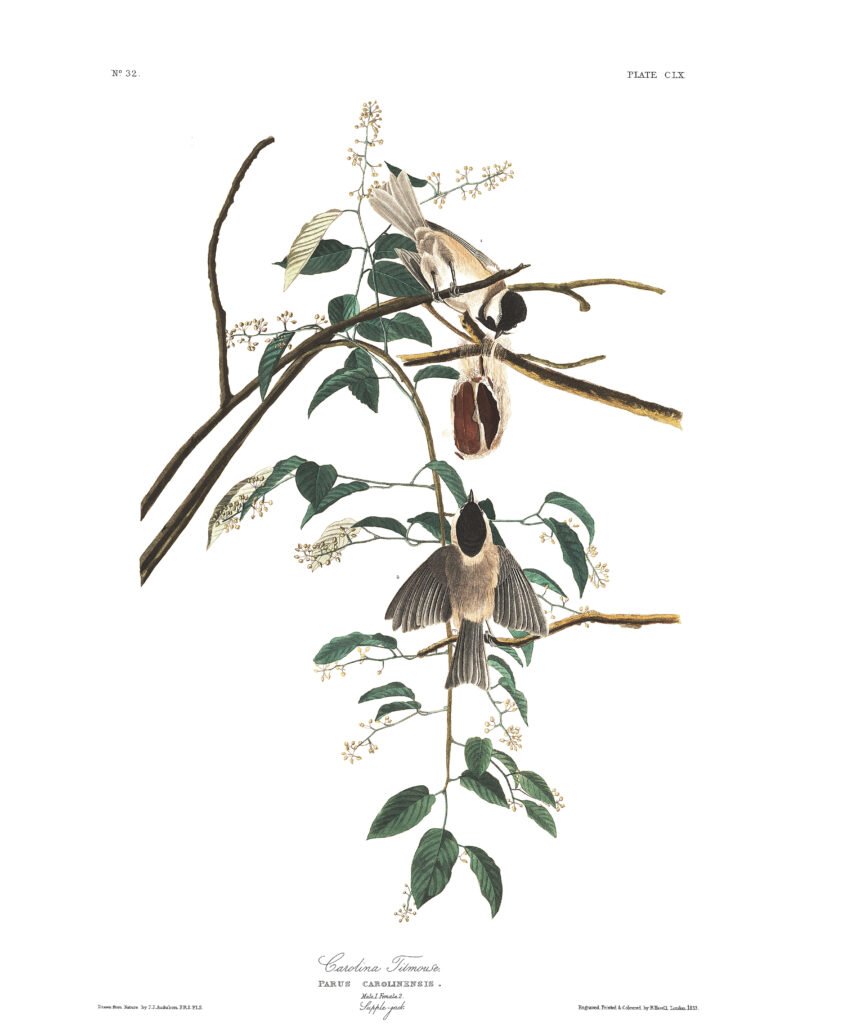
Description
The Carolina chickadee is very similar in appearance to the black-capped chickadee (Poecile atricapillus) and may be difficult to tell apart in areas where they overlap along the northern edge of the Carolina chickadee’s range. Carolina and black-capped chickadees may even mate and have offspring where they are found together; however, the two species are genetically distinct and likely diverged more than 2 million years ago.
In the Deep South, the Carolina chickadee is a distinct little round bird not easily confused with other species. With its bright white cheeks contrasting with its black cap and throat, the chickadee’s face is easily recognizable. Where the Carolina chickadee overlaps with the black-capped chickadee, look for the Carolina to be more solidly gray on its back and wings without any of the white edging on its flight feathers that may be found on the black-capped.
Summary: Carolina chickadee
| Scientific name | Poecile carolinensis |
| Timing | Year-round within breeding range |
| Habitat | Deciduous forests and open woodlands |
| Food | Primarily insects with more seed and fruit in winter |
| Feeders | Sunflower, peanuts, suet, mealworms |
Range
Carolina chickadees are non-migratory and remain within their breeding range year-round. They might be found in deciduous forests and open woodlands from central Florida north to Pennsylvania and west to Nebraska and central Texas. Carolina chickadees may also frequently inhabit suburban and urban areas with trees.
Winter
While a pair of Carolina chickadees defends a breeding territory in the summer, they will join wide ranging mixed-species flocks in the winter. Carolina chickadees will join with other small birds wintering in the southeast including tufted titmice (Baeolophus bicolor), ruby-crowned kinglets (Corthylio calendula), nuthatches (Sitta spp.), downy woodpeckers (Dryobates pubescens), and a variety of warblers in flocks that may contain over 50 birds. Titmice and chickadees are the ringleaders of these groups, using their extensive vocal repertoire to communicate threats, dominance status, and available food resources to the flock.
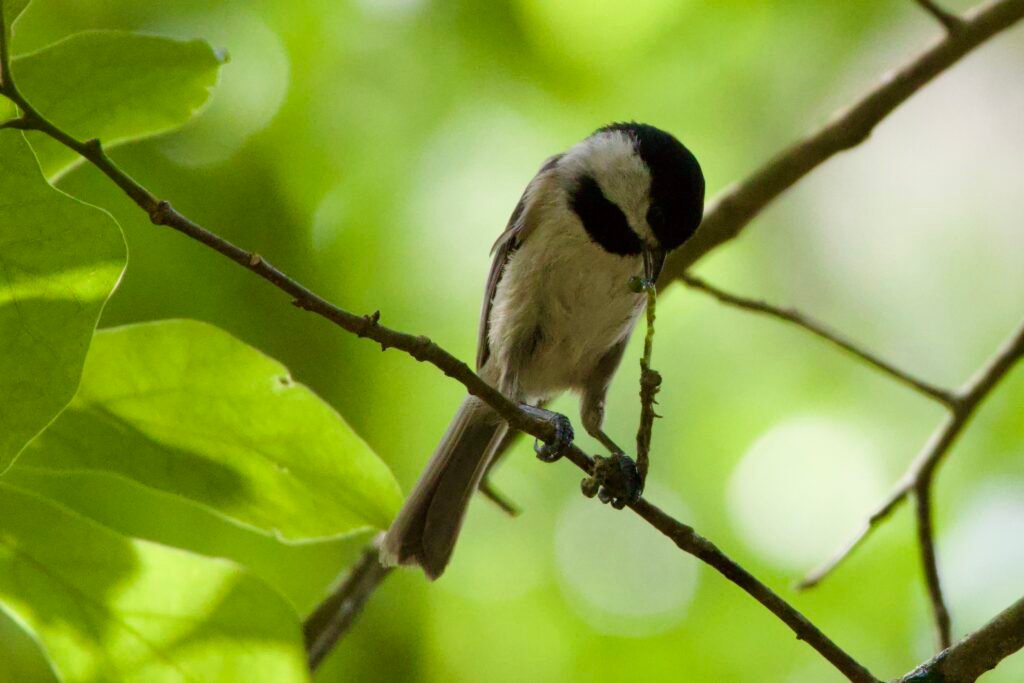
In the winter, Carolina chickadees will eat a wide variety of food including insects, spiders, seeds, and berries with invertebrates making up around 50% of their diets. They may cache food to retrieve within a few hours to a few days. Chickadees forage by gleaning insects from leaves and bark, often hanging by their feet upside down to reach underneath. They will frequently hold food between their feet and a perch to peck apart and eat larger items. As insects become more abundant in the spring, a chickadee’s diet will be comprised mostly of invertebrates, with caterpillars a particular favorite.
In late winter, Carolina chickadee pairs will establish breeding territories and excavate or find an unused cavity in which to build a nest. The chickadees most dominant in winter flocks will remain closer to their winter ranges, with less dominant birds forced to disperse to find summer territories. Carolina chickadee pairs appear to form mate bonds for multiple years, perhaps even for life.
Breeding
Carolina chickadees will use natural or artificial cavities for nesting. They may excavate their own cavities in the soft or decaying wood of trees like maple, birch, and oak, but will also use old cavities modifying the interior dimensions as needed. Generally, they prefer cavities between 4 and 15 feet high, but one study suggested they may prefer nesting higher since nests closer to the ground tended to be depredated more frequently. The female will construct the nest with moss and strips of bark lined with fur or plant fibers. She will lay 3 to 10 eggs in March-April and the pair will raise only one brood each season.

Carolina chickadees may feed their young over 6,000 caterpillars during the 2 to 3 weeks the chicks are in the nest. Researchers have found that Carolina chickadees rely heavily on native plants for the insects they need to reproduce and raise young. Areas with less than 30% native plant biomass produced fewer chickadee babies and may not be able to sustain a healthy population.
How to attract Carolina chickadees?
Carolina chickadees are an iconic feeder bird and you may reliably depend on them to show up to eat black oil sunflower seeds from just about any container you put out. But if you really want to create an oasis for chickadees in your yard, there are a myriad of ways you might enhance your garden to benefit them.
Habitat
While Carolina chickadees will eat at feeders especially during the winter, they still depend primarily on insects to meet their energetic needs and raise young. Supporting insect populations by planting native trees and shrubs and limiting use of pesticides will make it more likely Carolina chickadees will spend time in your garden and find your feeders.
Studies have found that Carolina chickadees prefer to forage for food in native trees as well as breed in areas with more native plants available. During the summer, chickadees specifically looked for their preferred prey, caterpillars, in trees that host the most Lepidoptera species including oaks (Quercus), maples (Acer), hickories (Carya), elms (Liriodendron), and pines (Pinus).
In winter, fruits of poison ivy (Rhus radicans) and ragweed (Ambrosia spp.) seeds appear to be important food for chickadees. Of course, neither of these plants are very welcome in a garden setting, but maybe it helps to know they are valuable plants for wildlife including our beloved chickadees.
I am terribly allergic to poison ivy and feel like I break out in an itchy rash just looking at the stuff. However, because I know it has a lot of benefit to wildlife, I do let poison ivy have free rein in naturalized parts of my yard that I do not venture into often. Ragweed has seeds with very high oil content that birds apparently love, but the high pollen content of this species wreaks havoc on the allergies of millions of people each fall making it a villain to many.
Red Maple
If you’re looking for a plant to add to your garden that will benefit Carolina chickadees as well as other wildlife, consider planting a maple tree if you have the space. Red maple (Acer rubrum) is one of the most widely distributed trees in eastern North America ranging from southern Florida north to Nova Scotia and west to Texas and Minnesota. Their abundance in the eastern deciduous forests can be attributed to its ability to adapt its root structure to a wide range of habitat conditions from dry sun to wet shade and everything in between. For the healthiest, happiest maple, plant it in deep moist acidic soil.
Most folks are familiar with maple trees thanks to their spectacular red color in the fall. In late winter, maples will produce flowers that are important sources of nectar and pollen for early season pollinators. Maples are host plants for over 200 species of moths and butterflies including the spectacular cecropia moth (Hayalophora cecropia). These caterpillars are critical sources of food for chickadees as well as other songbirds during the breeding season. White-tailed deer will browse maples and squirrels and birds enjoy eating the seeds.

All in all, a red maple will be a of great value to wildlife as well as a beautiful addition your yard. I planted a maple last year, with dreams of it decorating my back yard in its striking fall color in the future. Unfortunately, it was killed by marsh rabbits (Sylvilagus palustris) stripping the bark off the trunk. So I would recommend fencing off your little maple until it gets well established if you have a lot of bunnies or deer around to chew on it. I’ll try my luck and plant one again soon.
Bird Feeders
Carolina chickadees are very flexible in their use of bird feeders and will happily eat sunflower seeds, peanuts, suet, or mealworms from just about any container you offer them in. These smart little birds will be the first to figure out a new feeder set up and exploit it.
Sunflower seeds
If you want to start feeding chickadees in your yard, the easiest place to start is with a tube or platform feeder and some black oil sunflower seeds. Carolina chickadees will eat whole black oil sunflower seeds as well as chipped sunflower seeds without shells. You can read the details about how to get started with this bird feeder set up in my article “Birding Basics: the Best Bird Feeder Setup for Beginners.”
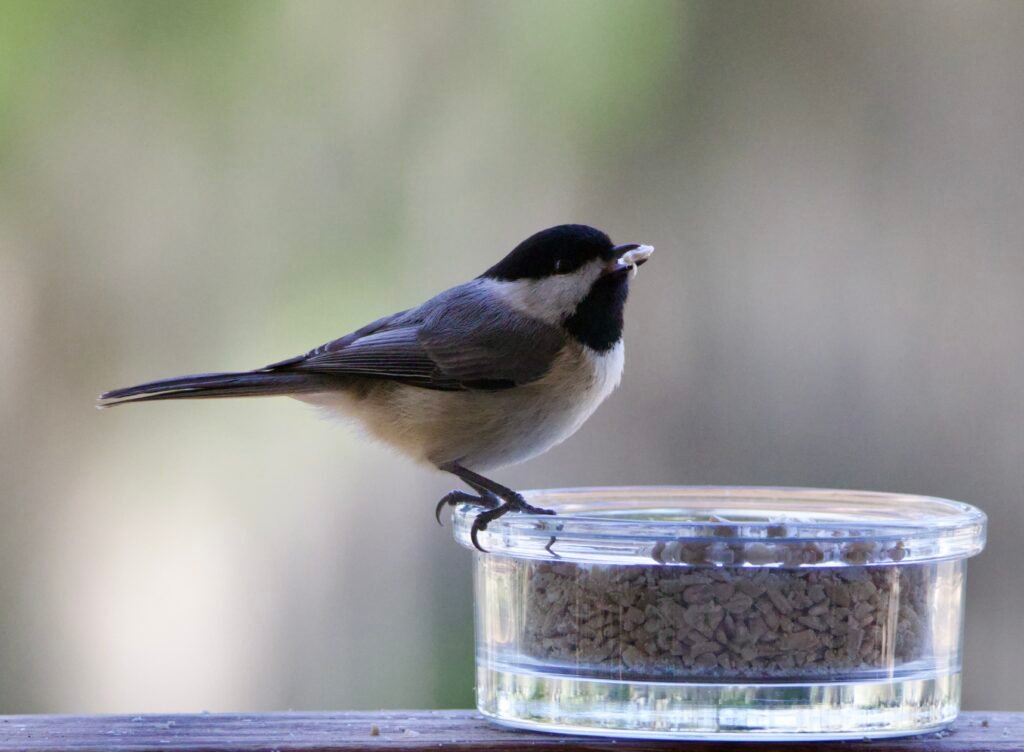
Peanuts
Peanuts are an irresistible treat for many garden birds, especially your woodpeckers. Your chickadees will also appreciate them particularly in the winter. There are a lot of options for offering peanuts to your birds, but as they are expensive and prone to spoilage, it’s a good idea to take some care in how you store and put them out in your yard.
You can find seed blends containing chips of peanuts; however, I find that shelled whole or half peanuts are more attractive to a wider variety of birds. You may toss these in your platform feeder, but I don’t feel this is ideal for a couple of reasons. First, peanuts grow mold easily when damp, so you don’t want them to be readily exposed to rain or dew. Second, since peanuts are a little pricier than other seed, watching mourning doves kick the peanuts out of the platform feeder onto the ground while they are searching for their preferred food can be an extremely frustrating experience.
I like to offer my peanuts in a tube feeder that is easy to clean, like the Droll Yankees Ring Pull Tube Bird Feeder with a seed tray to catch any fallen nuts and allow an easier perch for the larger birds. These are my absolute favorite feeders and you can read more about them in the above mentioned article. I also put only peanuts in this feeder. Watching woopeckers throw out all the other seed in search of the peanuts they adore is not worth the pain. Just use a separate feeder. Bottom line, put your peanuts in something that will keep them dry and limits waste.
Suet
Chickadees are little acrobats that will be able to reach your suet regardless of how you offer it, in cakes or cylinders or balls, it shouldn’t matter to them. Suet is just rendered beef fat that is usually mixed with corn and other ingredients like nuts and sometimes mealworms and fruit. You’ll want to be sure to buy the “no melt” variety if you plan to put it out year round in the South. My birds love the SuperSuet available at Wild Birds Unlimited. Its primary ingredients, peanuts, beef fat, mealworms, corn and other nuts, are all ground up into a homogenous block of suet that is seemingly irresistible to most birds. I generally offer my birds suet either as a cake in a standard suet cage or a cylindrical block on a hanging feeder with a weather dome.
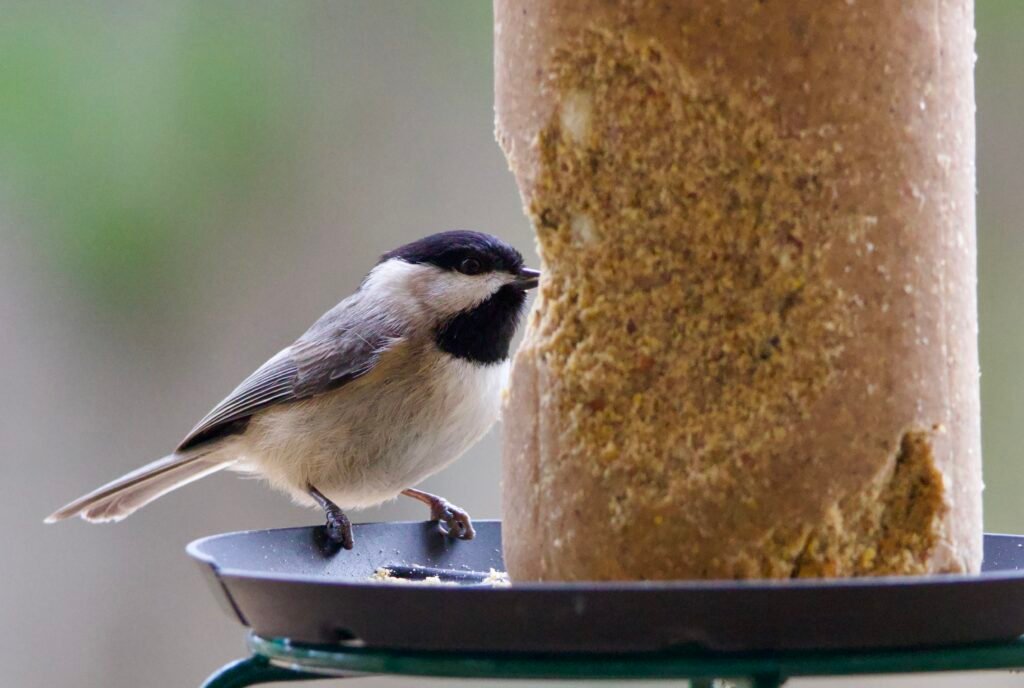
Mealworms
Chickadees will readily eat mealworms all year, but they will be crazy for them when they are raising young. Read my article about how to offer mealworms to your wild birds here.
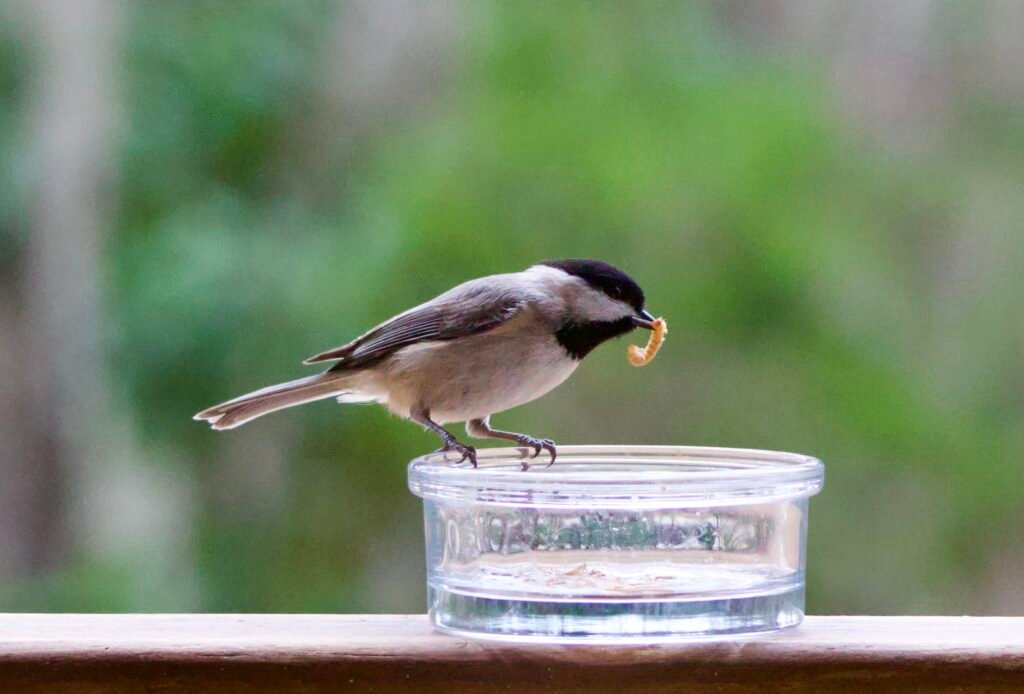
Nest Boxes
Carolina chickadees nest in tree cavities, but will use nest boxes or nesting tubes. NestWatch by the Cornell Lab of Ornithology has plans and information about how to construct a nest box for your Carolina chickadees. I built my chickadees their own box with the recommended 1 1/8 inch diameter entrance hole, but they insist on using the larger bluebird box. I’m not sure why this is, although I’ve read that other folks find their chickadees prefer the boxes with larger entrance holes when available.
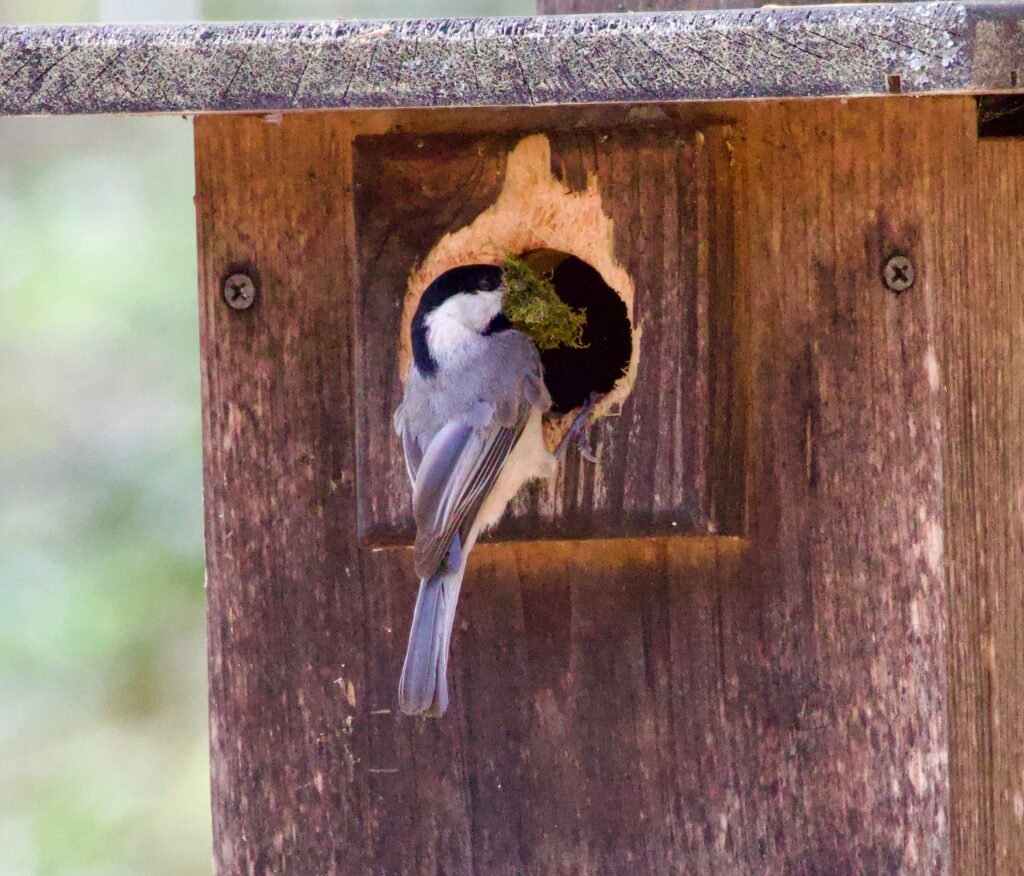
Carolina chickadees begin nest building as early as March in the southern parts of their range, so you’ll want to install your nest box in the winter to ensure they have a chance to find it before the breeding season. Generally, chickadees are flexible in where and how you place your birdhouse, so place it on a tree or pole where you will best enjoy watching them.
Nestwatch also provides some nice information about the features to consider when building or buying a birdhouse to make it as safe and successful a home for your birds as possible. A few things they suggest include using untreated wood, ensuring there is adequate drainage and ventilation, and utilizing baffles to keep the nest safe from climbing predator such as snakes and raccoons. A study round metal pole will allow the most flexibility for adding a baffle. The entrances on my boxes tend to get chewed on by flying squirrels, so I’ve also added metal predator guards to the entrance holes.
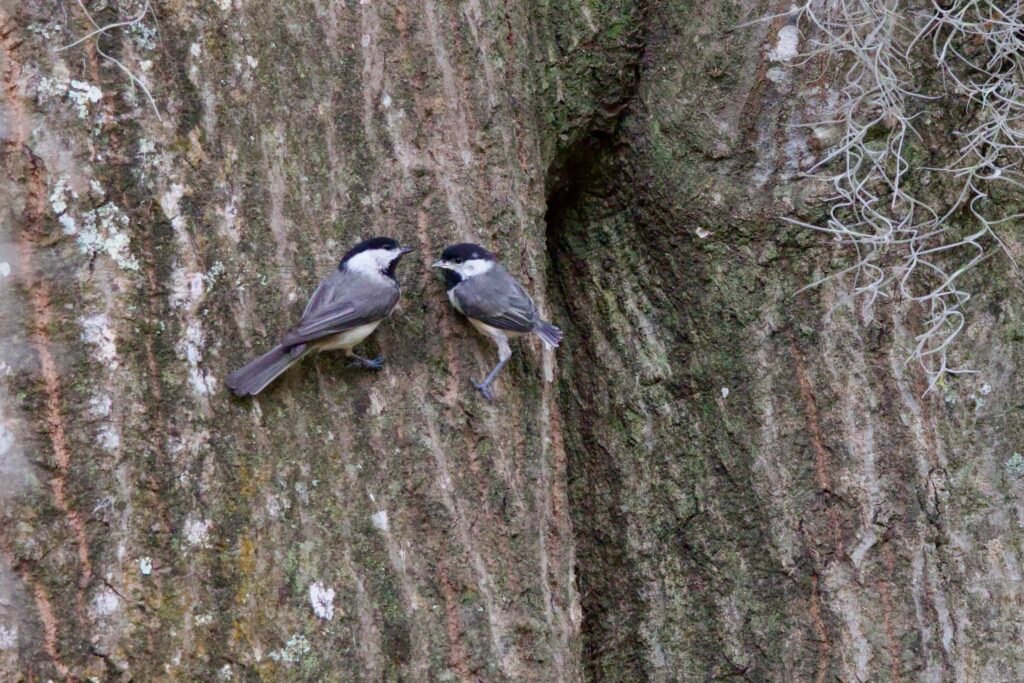
The female chickadee will sit tight on her nest while incubating eggs and brooding chicks. She makes a hissing noise if disturbed, probably in the hopes of startling any would be nest predators. Chickadee babies may be prone to leave the nest early if disturbed after 10 days old, so it’s best practice to just leave the birds in the box alone.
Other things to offer
Water
Carolina chickadees will drink from bird baths. Providing clean water, especially on hot days, will draw birds to your garden. The chickadees in my garden are extremely fond of drinking out of the ant moat for my hummingbird feeder. I have an extra large ant moat to keep the carpenter ants off the hummingbird feeder, and the little birds in my yard seem to think it’s their personal water fountain.
Nesting material
Carolina chickadees usually have what’s referred to as a “fur plug” at the top of their nests. They line the cup of their nests with fur and then have an extra “plug” of fur that they use to cover the eggs. So the point is that they are looking for fuzzy stuff for nesting material and you can provide that for them. I put out a ball filled with nesting material in the spring. Simply a sphere made of vines stuffed with cotton and fur, the nesting balls are used readily by Carolina chickadees, tufted titmice as well as the occasional yellow-throated warbler (Setophaga dominica). You can purchase nesting balls or similar items online or at your favorite bird store, or make them yourself. Most of my birds prefer the alpaca fur which can also be purchased online.
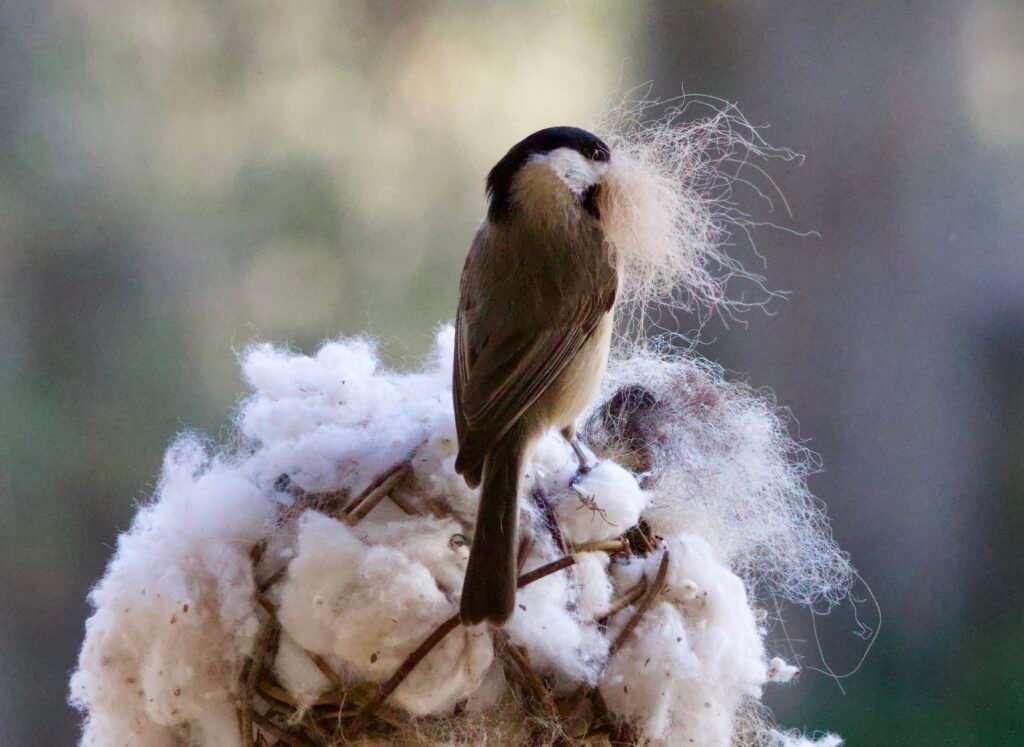
Where to learn more?
- American Scientist 2012: The Complex Call of the Carolina Chickadee by Freeberg, Lucas and Krams.
- Audubon Birds of America: Plate 160, Carolina Titmouse, Paris Carolinensis, Aud. Orn. Biog., Vol. I. P. 341; vol. v. p. 474.
- Audubon Bird Guide: Carolina Chickadee
- American Bird Conservancy Bird Library: Carolina Chickadee “Choosy Neighbor”
- International Journal of Zoology 2011: Leadership of Winter Mixed-Species Flocks by Tufted Titmice (Baeolophus bicolor): Are Titmice Passive Nuclear Species? By Contreras and Sieving
- Journal of Ornithology 2008: Characterizing complex mixed-species bird flocks using an objective method for determining species participation by Farley, Sieving and Contreras.
- PNAS 2018: Nonnative plants reduce population growth of an insectivorous bird by Narango, Tallamy, and Marra.
- Biological Conservation 2017: Native plants improve breeding and foraging for an insectivorous bird by Narango, Tallamy and Marra
- Sialis: All About Carolina Chickadees
- NestWatch: Carolina chickadee nest box plan and information
- NestWatch: Features of a Good Birdhouse
- The Condor 1992: Nesting Mortality of Carolina Chickadees Breeding in Natural Cavities by D. Albano
- Nestwatch: What to do about predators
- UF/IFAS Featured Creature: Cecropia Moth
- The Auk 1963: Ecological and Reproductive Relationships of Black-Capped and Carolina Chickadees by Richard Brewer
- Backyard Ecology: Red Maple: An Early Source of Nectar and Pollen
- Animal Behavior 1991: When should chickadees hoard food? Theory and experimental results by Lucas and Walter
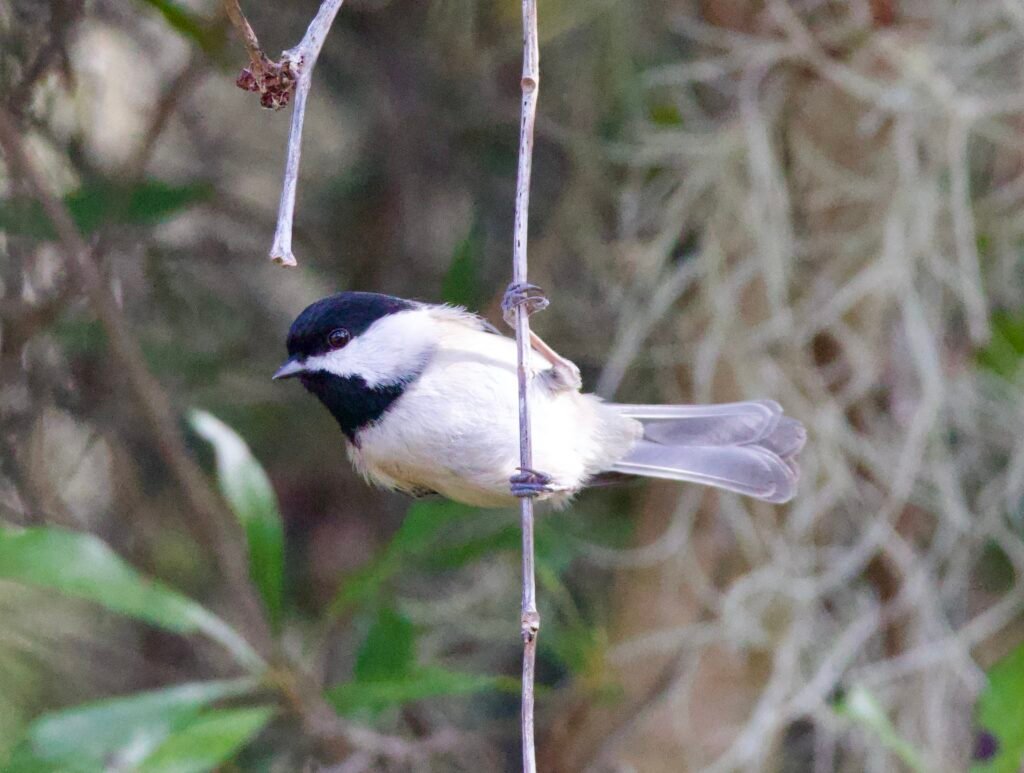
Great article! I always enjoy your writing 🙂
Love chickadees and loved your informative blog. Great pics too!
Really enjoy your writing and great pictures. Looking forward to more!
Pingback: The Southern Wild - Best Bird Feeder Setup for Beginners
Pingback: Raising Mealworms for Wild Birds - The Southern Wild